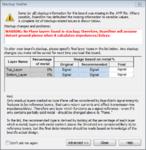mostafanfs
Member level 1
Hi
when I run HyperLynx BoardSim it asks for considering a plane layer and based on what it says it seems it's calculations and simulations are all based on existence of plane layer(s).
What I have to do ? My PCB Layout has only 2 simple layers.Top Layer And Bottom Layer. So by opening board this window come up and you can see the warning. It seems BoardSim needs reference layers that can carry return currents as you can see in Hint section.

I even designed stackup based of my plan in Stackup Editor.
So I think all of my simulations and Resistor Termination calculations was wrong. Am I right ?
I cant just add a plane layer because there is not any plane layer.
Please someone explain what exactly this window says and what should I do ?
What does it mean by that WARNING ?
I really need to understand this. Thank you
when I run HyperLynx BoardSim it asks for considering a plane layer and based on what it says it seems it's calculations and simulations are all based on existence of plane layer(s).
What I have to do ? My PCB Layout has only 2 simple layers.Top Layer And Bottom Layer. So by opening board this window come up and you can see the warning. It seems BoardSim needs reference layers that can carry return currents as you can see in Hint section.

I even designed stackup based of my plan in Stackup Editor.
So I think all of my simulations and Resistor Termination calculations was wrong. Am I right ?
I cant just add a plane layer because there is not any plane layer.
Please someone explain what exactly this window says and what should I do ?
What does it mean by that WARNING ?
I really need to understand this. Thank you
Last edited: